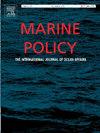High rate of ship strike to large whales off Chile: Historical data and proposed actions to reduce risk
IF 3.5
2区 社会学
Q2 ENVIRONMENTAL STUDIES
引用次数: 0
Abstract
Ship strikes are a worldwide threat to large whales as a major cause of mortality and injury. In the Southeast Pacific, this has been poorly studied. In the last decade, an increase in ship strikes has been observed off Chile. This study assesses ship strike mortality in large whales off Chile using data on fatal strandings from the past 52 years, (1972–2023) and vessel traffic patterns. In 63 out of 226 strandings (28 %), ship strike was the direct or probable cause of mortality, i.e. the primary cause of non-natural death in whales. Fin whales (B. physalus) suffered highest total ship strikes (n = 23; 37 %), followed by humpback (M. novaeangliae) (n = 13; 21 %), blue whales (B. musculus) (n = 7; 11 %), sei (B. borealis) and sperm whales (P. macrocephalus) (n = 6; 10 %). Ship strikes were highest in the Regions of Valparaiso, Coquimbo, Atacama and Antofagasta (Central-Northern Chile), Los Lagos, Aysen and Magallanes (Southern Chile). Since 2013, when necropsies began to be systematically performed, an average of 5 individuals/year have been killed by ships, mostly between January and May. We review all ship strike studies globally and compare rates in Chile with those elsewhere. Based on data between 2013 and 2023, Chile is the country with the highest ship strike mortality globally; considering the entire time series since 1972, Chile ranks number six worldwide. We identify major knowledge gaps and recommend policy measures, including establishing High-Risk Areas and the implementation of shipping lanes modifications and vessel speed restrictions.
求助全文
约1分钟内获得全文
求助全文
来源期刊

Marine Policy
Multiple-
CiteScore
7.60
自引率
13.20%
发文量
428
期刊介绍:
Marine Policy is the leading journal of ocean policy studies. It offers researchers, analysts and policy makers a unique combination of analyses in the principal social science disciplines relevant to the formulation of marine policy. Major articles are contributed by specialists in marine affairs, including marine economists and marine resource managers, political scientists, marine scientists, international lawyers, geographers and anthropologists. Drawing on their expertise and research, the journal covers: international, regional and national marine policies; institutional arrangements for the management and regulation of marine activities, including fisheries and shipping; conflict resolution; marine pollution and environment; conservation and use of marine resources. Regular features of Marine Policy include research reports, conference reports and reports on current developments to keep readers up-to-date with the latest developments and research in ocean affairs.
 求助内容:
求助内容: 应助结果提醒方式:
应助结果提醒方式:


